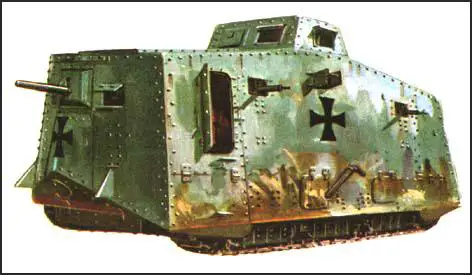Schwerer Kampfwagen A7V
After British tanks went into action on 15th September, 1916, the German Army immediately demanded their own landships. The German High Command appointed a committee composed of experts from leading engineering companies. Josef Vollmer was eventually chosen to design the German tank that became known as the Schwerer Kampfwagen A7V.
Powered by two Daimler engines, the tank was first demonstrated in the Spring Offensive of 1917. In addition to six water-cooled machine-guns, it had a 5.7-cm Sokol gun at the front of the vehicle. A hundred of these tanks were ordered and the first of these were ready in October 1917.
The Schwerer Kampfwagen A7V was first used at St Quentin on 21st March 1918. Although some of its features, such as the sprung tracks and the thicker armour, made it better than British tanks at that time, the A7V was less successful as a battle vehicle. The main problems concerned its mechanical reliability and the difficulty it encountered crossing enemy trenches.

Primary Sources
(1) Percival Phillips, The Daily Express (26th April 1918)
For the first time British and German tanks have met in battle, and the victory is ours. They fought yesterday in the open fields round Villers-Brettonneux, east of Amiens, where the enemy made a determined and, for the moment, a successful attack on that town and high ground round it.
The German tanks led the attack, swinging on the town from the north-east and from the south, and in their wake came infantry with their machine guns and heavy mortars and light artillery.
Although there were four or five tanks. They were bulky, ungainly creatures, quite unlike the British tank in appearance, with a broad, squat turret containing quick-firing guns. Hidden in the thick mist until very close to our trenches, they crawled up in the wake of an intense barrage about six o'clock in the morning.
They concentrated their guns on one British tank, but others came to the rescue, and in the brief duel that followed one enemy tank was put out of action by an opponent of less bulk and lighter armament and the others scuttled away.
The lesson of this first engagement between German and British tanks seems to be that we have nothing to fear from the enemy despite the greater size and armament of his machine. The crews plainly showed their unwillingness to stand when invited to fight out to a finish.
